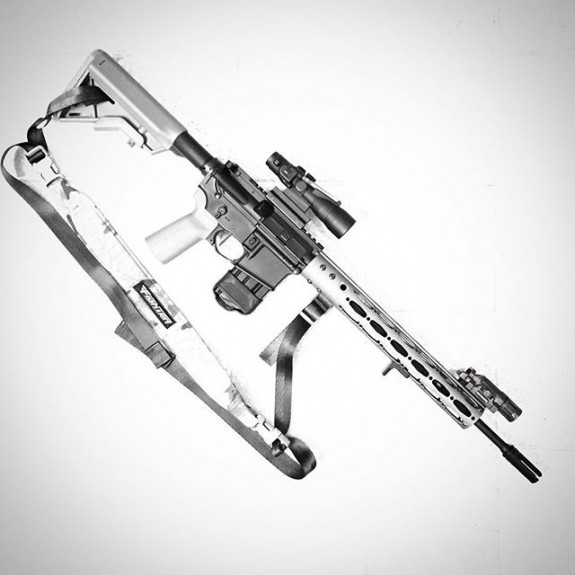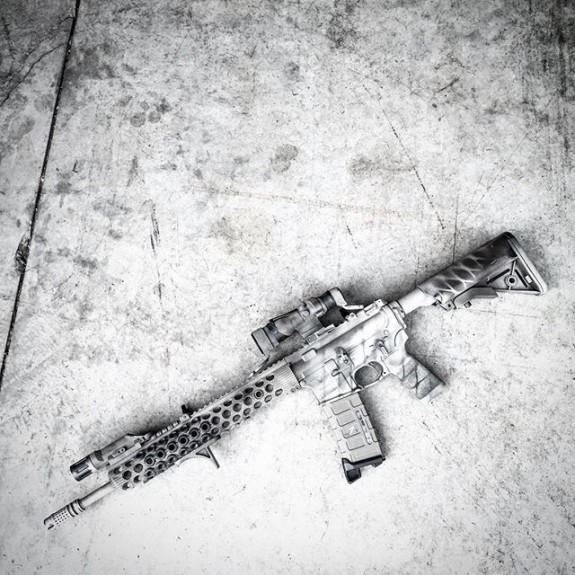I received two similar questions last week from readers and some variation of these questions come in pretty frequently. While I know that very often gear is chosen to be specific to certain tasks and it tends to work out better that way, I completely understand the search or desire for The One Rifle that can do it all (even though I am not sure it exists).
From Dale S. who is building his first AR-15 (and thinks it will be his only AR-15, but all us current AR-15 owners know better):
If you could only have one AR-15, what would you get? Can you please be specific about parts?
From Matt S. who wants the “perfect bugout rifle”:
I’m trying to build a general-purpose/bugout rifle… How would you build it?
I am not sure what my opinion is worth (and I have never had to “bugout”) but I have settled on a rifle configuration that works pretty well for me across a lot of situations and is pretty easy to live with. My idea of a general purpose rifle is one that can be effective at a variety of distances and is easily used in a variety of situations. It should be light enough to carry easily and accurate enough to work well across the effective range of the cartridge being used (I am assuming 5.56 for this article).
Both questions mention “parts” or a desire to build so my recommendations will be along those lines. Neither question mentioned a price range so I won’t really consider price though most of the parts I use aren’t really specific to a brand – more like specific to a certain type – which leaves you free to choose the brand/model that fits your budget.

An ALG Defense EMR, Faxon Lightweight Midlength Barrel, and Trijicon TA33 keep this rifle light, trim, and capable.
Barrel
The barrel that you choose really seems to play the single largest role in how a rifle will feel and behave. The barrel will dictate how heavy or light the rifle feels, how accurate it can be, and plays a role in reliability as well. My tastes are broad here. I like a lighter profile barrel with better than average accuracy. Simple.
Lightweight profile barrels get a bad rap for poor accuracy but it is mostly undeserved. Will their groups open up a bit as they get warm? Sure, but it has also been my experience that they can tend to be very accurate. Whether this is due to some harmonics advantage from being a relatively straight profile like some claim, I don’t know. I just know they work and if you choose a good one, there is plenty of accuracy potential. Chances are, if you miss at typical carbine range, it’s not because the barrel was hot.
I’ve used many lightweight barrels and have come to like several over the years. Faxon Firearm’s Lightweight and Gunner barrels are a great budget option. The BA Hanson profile barrels from Ballistic Advantage are a great value and ideally suited to this type of build. BCM‘s lightweight profile BFH barrels also work well in this role and I have come to trust them completely. Colt’s lightweight barrels are also known performers. Every SIONICS barrel I have touched has been an excellent shooter.
Optic
I think a general purpose rifle should have some magnification since its very name indicates it is to be used across a variety of purposes which, for a rifle, means a variety of distances or levels of precision. Given the capabilities of the AR-15 and it’s caliber, the optic needs to support shooting from muzzle distance out to 300 yards (or more). To me that means 3-4x magnification.
I like the Trijicon TA33 ACOG in this role – it’s super light, bomb-proof, and works well at a variety of distances. I am not picky about the reticle. Choose the one that suits you. You can read more about why I like the TA33 in JTT’s previous article on the topic.
An Aimpoint and magnifier works really well on a general purpose carbine but isn’t lightweight (see JTT’s article on maximizing this setup). If you want a budget option, check out the Weaver V3 1-3×20. It’s actually a great little optic that used to be quite common in practical rifle competitions and it is very lightweight especially when paired with lightweight mount like those from Aero Precision.
Rail
I have found that a slick-sided, extended free float rail can be lighter than polymer handguards and they give me the maximum leeway in how I support the rifle. A 12-13″ handguard is long enough and allows me to support the fore end of the rifle however I want whether I am bracing on a barricade, shooting off-hand with a tight sling, resting on a log, or any other way I can think of to steady the rifle.
I like ALG Defense’s EMR rails. They are affordable, lightweight, and high quality. I’ve also used rails from Geissele Automatics, SLR Rifleworks, MI, Troy, Parallax Tactical and others.
Trigger
If you choose a light optic, light barrel, and light rail, your carbine is likely to be pretty light in weight. I find that lightweight carbines are easier to shoot well with light(ish), clean breaking triggers. If your carbine weighs 7ish pounds and your trigger takes 10 pounds to break, that can be a challenge (but with good trigger control, its nothing you can’t handle). I like the Geissele SD-C, SSA, or similar. However…
This is a good place to save money. If you don’t want to spend on something like a Geissele trigger, just make sure the lower parts kit you use is of good quality so that you have a decent standard fire control group. There is nothing wrong with using a standard fire control group.
Other Stuff
Other than what I listed above, I don’t really have a lot of preferences other than keeping things light and easy to live with. Here are some basic guidelines:
- Buy a bolt carrier group of known quality. I generally buy from SIONICS.
- I don’t get wrapped up in furniture as long as it works, is comfortable, and light. It is hard to beat the UCWRG Grip 23 for a general purpose grip.
- Use lightweight small parts where ever you are able. An overall approach to reducing weight can make a noticeable difference.
- I don’t compromise recoil system weight in the name of keeping weight low. I like M16 carriers and a buffer of an appropriate weight for the gas system.
- The muzzle devices I use are across the board. The good old A2 works fine.
- I like a handstop on my slick-sided free float tubes but it isn’t necessary.
- The rifle should have a weapon light mounted in a way that is easily accessible. Keep it lightweight.
- You need a sling. I like Blue Force Gear Vickers Slings but there are several great options out there.

This carbine has a compete BCM BFH Lightweight Midlength Upper and is almost as old as the TA33 optic itself.
If you don’t want to build your own rifle, the SIONICS Patrol Rifle III is basically exactly what I outlined here and their lightweight barrels are real shooters. Just add an optic. BCM also makes several appropriate models with lightweight barrels.
Those of you who follow Cola Warrior will see similarities between this and the CWAR spec that is so common in their particular brand of practical rifle competition. I’ve been using a rifle like this going back to a few months after the TA33 was released (before green reticles were even available!) and I’m glad to see that others have separately come to value to the general utility of a similar configuration.
Wrap Up
To boil this down even further – think light weight and match the optic to the strengths of the cartridge. The barrel and optic, in my experience, are what have the greatest effect on the perception of a particular carbine’s characteristics. That is really about as specific as I need to be. I have built what amounts to basically the same carbine several times following these guidelines and I am always pleased with it.

I like that you are plugging for the UCRWG grip, but since we are talking about a bugout rifle, It can’t be overstated that the ability to flip the safety on and off without breaking the firing grip while conducting fire and maneuver is paramount. I found for me that a safety selector with a 45- 60 degree angle makes it possible, I am very happy with my V7 57 degree selectors. On a related note, I found that all my UCRWGs needed the detent spring hole drilled down about 1/16″-1/8″ further with a #32 drill to relieve excess tension on the detent spring so the selector stays put, but is not stuck in place.
Spot on write up. I made similar choices building my ‘one’ gun. Went with a 1-6 optic instead of the trijicon, and settled on a 12.5″ barrel. 85-90% the velocity of a 20″ and much shorter. Alg triggers are unbeatable for the money.